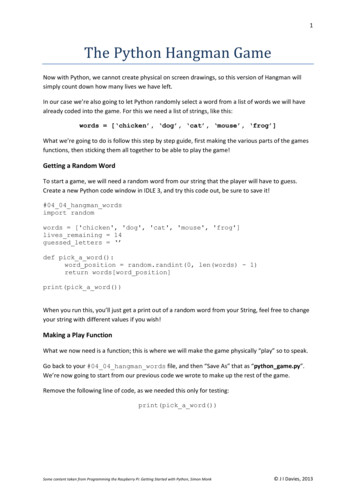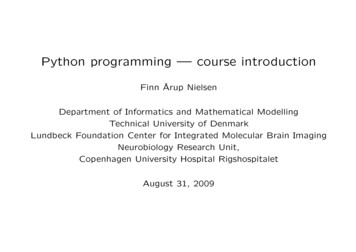
Transcription
1The Python Hangman GameNow with Python, we cannot create physical on screen drawings, so this version of Hangman willsimply count down how many lives we have left.In our case we’re also going to let Python randomly select a word from a list of words we will havealready coded into the game. For this we need a list of strings, like this:words [‘chicken’, ‘dog’, ‘cat’, ‘mouse’, ‘frog’]What we’re going to do is follow this step by step guide, first making the various parts of the gamesfunctions, then sticking them all together to be able to play the game!Getting a Random WordTo start a game, we will need a random word from our string that the player will have to guess.Create a new Python code window in IDLE 3, and try this code out, be sure to save it!#04 04 hangman wordsimport randomwords ['chicken', 'dog', 'cat', 'mouse', 'frog']lives remaining 14guessed letters ‘’def pick a word():word position random.randint(0, len(words) - 1)return words[word position]print(pick a word())When you run this, you’ll just get a print out of a random word from your String, feel free to changeyour string with different values if you wish!Making a Play FunctionWhat we now need is a function; this is where we will make the game physically “play” so to speak.Go back to your #04 04 hangman words file, and then “Save As” that as “python game.py”.We’re now going to start from our previous code we wrote to make up the rest of the game.Remove the following line of code, as we needed this only for testing:print(pick a word())Some content taken from Programming the Raspberry Pi: Getting Started with Python, Simon Monk J I Davies, 2013
2Now we’ll need the following:def play():word pick a word()while True:guess get guess(word)if process guess(guess, word):print('You win! Well Done!')breakif you’ll need to work out this bit:print('You are Hung!')print('The word was: ' word)breakOk, so now you’ve got this code, there’s an If statement incomplete.Here’s a hint, the IF statement is there to tell the user they have no lives left, you’ll need to use thelives remaining variable and one of the following operators: Equals ! not equals greater than less than greater than or equal to less than or equal toNote the indentation you use is important; it should look like this when in IDLE:Some content taken from Programming the Raspberry Pi: Getting Started with Python, Simon Monk J I Davies, 2013
3We cannot run this code we have at the moment because the functions get guess andprocess guess don’t exist yet.Firstly, add this code to your game:def pick a word():word position random.randint(0, len(words) - 1)return words[word position]This picks a word from your list.Getting a GuessWe need a way to tell the player how they’re doing, and what the word looks like. For this we’llcreate a function, as follows:def get guess(word):print word with blanks(word)print('Lives Remaining: ' str(lives remaining))guess input(' Guess a letter or whole word?')return guessWhat we are doing here is printing the status of the players guessing efforts, from our“print word” function we’ll be adding later.Then we print the amount of lives remaining to the player using print(). Finally we are returningguess, which is what the user entered.Some content taken from Programming the Raspberry Pi: Getting Started with Python, Simon Monk J I Davies, 2013
4Printing the WordWe’re going to keep the player updated after each guess of how their guessed word is looking, andas to what letters they’ve guessed. So this is where we need our “print word” function. Todisplay and update this, we’ve created a String variable at the beginning of the guide:guessed letters ‘’By using this String, we can store the word in its current state every time the player makes a guess.You’ll need all the code:def print word with blanks(word):display word ''for letter in word:if guessed letters.find(letter) -1:# letter founddisplay word display word letterelse:# letter not founddisplay word display word '-'print(display word)This is a loop that compares the letter the player entered with every letter of the randomly selectedword.It adds a hyphen (-) if the letter is guessed wrong, otherwise it will provide the position of the letterin our String.Processing the GuessWhen a player guesses, they will either be entering a single letter, or the whole word. Therefore weneed to use an IF in the process guess function, to tell the game which results to return afterthe user enters their guess:def process guess(guess, word):if len(guess) 1 and len(guess) len(word):return whole word guess(guess, word)else:return single letter guess(guess, word)Here, if the guess length is more than 1, then we’ll return “whole word guess”, otherwise it’llreturn the “single word guess”, these are explained on the next page.Some content taken from Programming the Raspberry Pi: Getting Started with Python, Simon Monk J I Davies, 2013
5Adding the Single Letter and Whole Word functionsThese three functions are important, as they decide what the game will do after a player makes aguess. We return true if the guess was correct, and false if it was incorrect.Copy this code snippet to your program:def whole word guess(guess, word):global lives remainingif guess.lower() word.lower():return#the word guessed is right, what should be returned?else:lives remaining – 1#the above is also wrong, can you see why and fix it?#this is to do with the syntax of adding to a variablereturn Falsedef single letter guess(guess, word):global guessed lettersglobal lives remainingif word.find(guess) -1:# letter guess was incorrectlives remaining lives remaining – 0#the above line of code is wrong, can you see where?guessed letters guessed letters guess.lower()if all letters guessed(word):return Truereturn Falsedef all letters guessed(word):for letter in word:if guessed letters.find(letter.lower()) -1:return Falsereturn Trueplay()Here’s a test, I’ve broken this snippet, as I’ve commented above where you need to try and work outand fix them.If you’re stuck, give me a shout.Some content taken from Programming the Raspberry Pi: Getting Started with Python, Simon Monk J I Davies, 2013
6Playing the GameYou should now be able to run this without any errors. If there are errors, check your syntax, andthen ask for the solution print out!There are some limitations during game play, but you can type either a letter in lower or upper caseand it will still guess them and process the guesses correctly.Some content taken from Programming the Raspberry Pi: Getting Started with Python, Simon Monk J I Davies, 2013
The Python Hangman Game Now with Python, we cannot create physical on screen drawings, so this version of Hangman will simply count down how many lives we have left. In our case we’re also going to let Python randomly select a word from a list of words we will have already coded into










